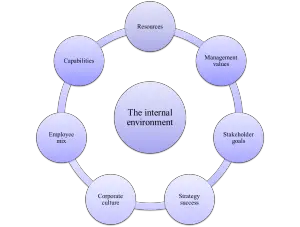Contents
What is the internal environment in marketing?
The  internal environment in marketing refers to components INSIDE the firm that are unique to the firm. An analysis of the internal environment is critical in the development of marketing strategy to ensure to ensure that the firm’s strategy is based upon its situation, resources and goals.
internal environment in marketing refers to components INSIDE the firm that are unique to the firm. An analysis of the internal environment is critical in the development of marketing strategy to ensure to ensure that the firm’s strategy is based upon its situation, resources and goals.
Firms that do not consider the internal environment when structuring their marketing strategy will end up with a very generic strategy – one that is similar to other organizations in the same market – and will not draw upon their unique strengths and competitive advantages.
What are the main internal environment factors?
The main factors to consider when analyzing the internal environment in marketing are:
- Resources
- Employee skills and mix
- Capabilities and core competencies
- Management values and corporate culture
- Stakeholder goals
- Current strategy and success
Resources
Resources is a broad term that refers to what the organization has. In marketing terms, we are particularly interested in: product range, brand equity, financial position, customer loyalty, customer base size, retailer relationships retailer relationships, access to technology, manufacturing skills and innovation, and so on.
In other words, it should be a list and review of what the firm has to work with.
Employee skills and mix
This is related to resources above, but is a closer focus on human resources. It is particularly valuable in service firms that rely on customer – employee interaction and in organizations that rely upon innovation and improved operations being delivered by key staff.
Capabilities and core competencies
This relates to skill sets and abilities and processes that the firm has AND is really good at. This should be a fundamental building block of the firm’s marketing strategy – as it will create opportunities for sustainable competitive advantage in the marketplace.
Examples of capabilities would include: innovation skills, speed to market, brand building expertise, data/marketing insights, cost efficiencies and processes, customer relationships, use of new technologies, and so on.
Management values and corporate culture
Management values refers to the top management/executive of the organization and how they view strategy and what is important to the organization. For example, some key people in management might see innovation and change as critical to success, but top level management in other organizations may be quite conservative and risk adverse.
What is important to management needs to be taken into consideration, as they are the ultimate approvers of competitive marketing strategy.
Top management values are evident by the overall corporate culture of the organization, which is influenced and guided by management views.
Stakeholder goals
In terms of stakeholder goals, we need to consider the owners/shareholders of the business and what they trying to achieve. Sometimes it is very profit and growth driven, but for some organizations there could be a social goals aspect as well.
Other stakeholders to consider would include employees and what is important to them – which needs to be understood, particularly for a service firm.
Current strategy and success
The current marketing strategy and its degree of success needs to be evaluated. How well is the current strategy working given the firm’s internal and external environments?
Obviously, successful strategies primarily need a fine-tuning only, whereas unsuccessful or weakening strategy positions would need substantial revision.
